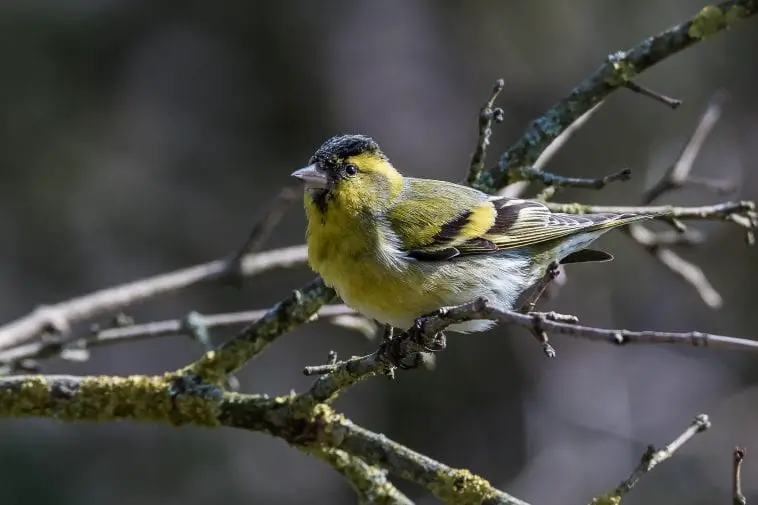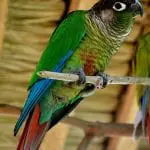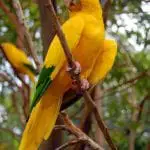Scientific Facts
| Common Name | Eurasian Siskin |
| Scientific Name | Spinus spinus |
| Lifespan | 13 Years |
| Size | 4.3 – 4.9 inches |
| Mass | 0.35 – 0.63 oz. |
| Habitat | Coniferous and mixed woodland |
| Range | Europe, Asia, north of Africa |
Information & Physical Appearance
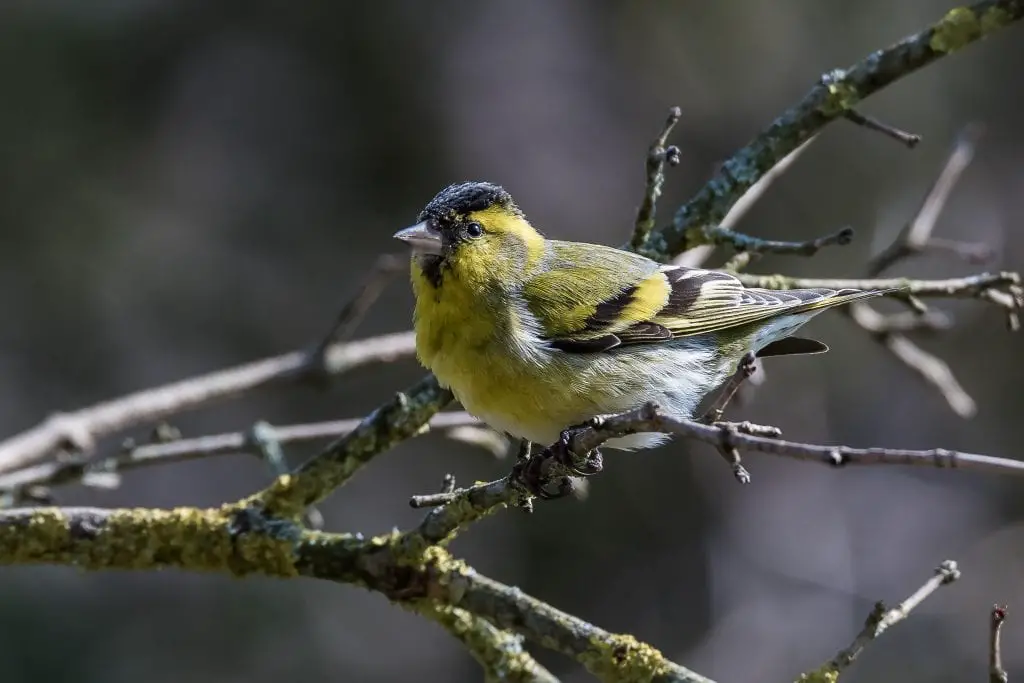
Scientifically referred to as Spinus spinus, the Eurasian siskin is a small-sized passerine bird. It belongs to the true finch family, the family Fringillidae. Other common names include siskin, European siskin, and common siskin. According to experts, the Eurasian siskin may have reached America either from Europe (in particular, from Iceland/Greenland) or from Asia. Spinus Spinus is actually the extent of parental species of one of the three evolutive radiations of pinus, dominicenses, and triceps finches found in North America.
Additionally, there are existing records of Eurasian siskins in the East and in the Aleutian Islands, which further contributes to the suggested theory that this bird species did enter, or may still attempt to enter the USA from Western Europe, more specifically, through Iceland/Greenland.
Even though the common siskin is found across a large area, it is a monotypic species, meaning that there are no distinct subspecies up-to-date.
The possible reasons for the lack of distinct subspecies can be explained by several factors, such as the wide overwintering area which makes up for a genetic interchange on a constant basis, the spatial variability of Eurasian siskin individuals in breeding areas from one year to another, as well as the way female species are known to lay a number of clutches of eggs in one single breeding season, with each clutch being in a different place from the others.
The Eurasian Siskin is “equipped” with a short tail. This small-sized passerine bird has a wingspan of 7.9 and up to 9.1 inches. It is by the color of the plumage how Spinus Spinus can be successfully distinguished from other finches that are similar in appearance.The underparts of the common siskin are white in color and are streaked in grey. The upper parts display hues of greyish green. The short tail is black in color at the end, while the sides are yellow in color.
These birds have a clearly visible yellow wing bar, as the vivid yellow coloration opposes the wings’ black coloration.
Sexual dimorphism shows in these birds’ appearance.
While the adult male Eurasian siskins’ face and breast are mainly yellow, with females, the face and breast zone are greyish green. Also, females lack the neat black cap that is typical for males. Instead, the cap and ears of females are greenish in color.
The yellowish coloration in the breast zone of mature male siskins becomes whiter towards the cloaca, and it also becomes striped. The chin patch, also known as a bib, is black in color, with the amount of black being quite variable among different male individuals.
Young Eurasian siskins resemble the appearance of adult females, as the young do also have no cap, and their heads are colored in greyish green. Apart from sharing similar coloration with females, colored in dull, light-brown tones, the immature siskins’ plumage is more subdued, too.
The chin patch, also known as a bib, is black in color, with the amount of black being quite variable among different male individuals.
The Eurasian siskin’s beak shape is determined by the bird’s feeding habits. Because of this, the beak is slender, yet it is also strong for the purpose of picking up the seeds, which are the primary food source. In addition to that, the short bill is characterized by a de-curved culmen.
The eyes of Spinus spinus are black in color. The feet and legs are dark browns.
Even though the Eurasian siskin is a bright bird in many plumages, thus, being fairly easy to recognize, it is sometimes possible to confuse this bird species with other members of the finch family, in particular, the European serin, the greenfinch, and the citril finch.
Lifespan
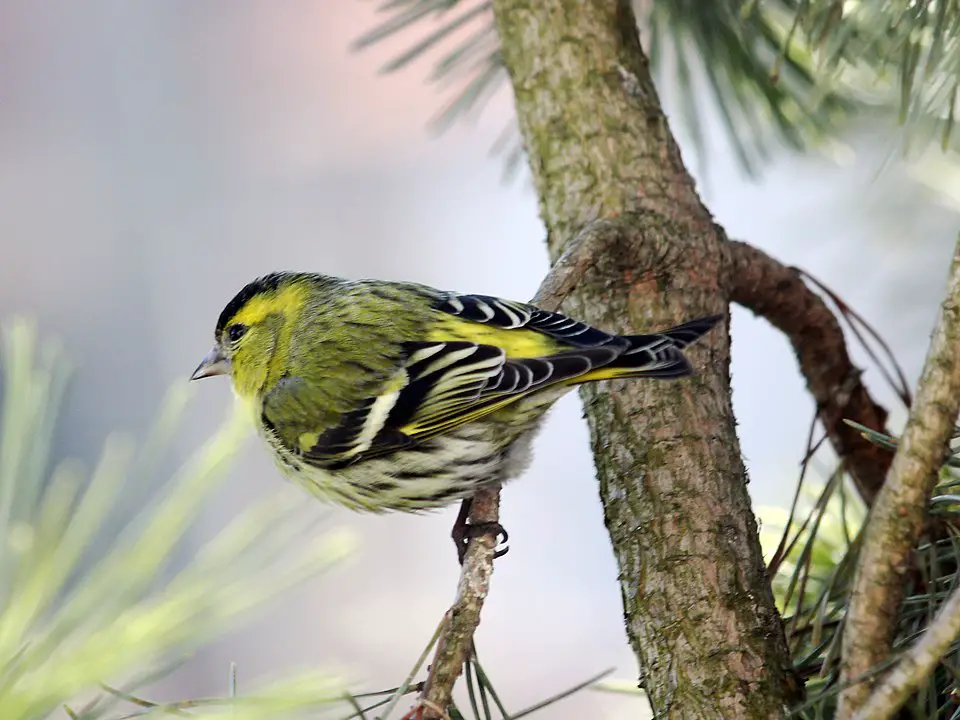
According to the Animal Ageing and Longevity Database, the maximum recorded longevity of Eurasian siskins is 13.5 years of age, which was the case with a wild Spinus Spinus specimen.
Usually, these birds will rarely live up to more than 13 years of age. When raised in captivity, the lifespan of these birds is estimated to be the longest, since, in the wild, they typically live for more than 2-3 years.
Ecosystem & Habitat
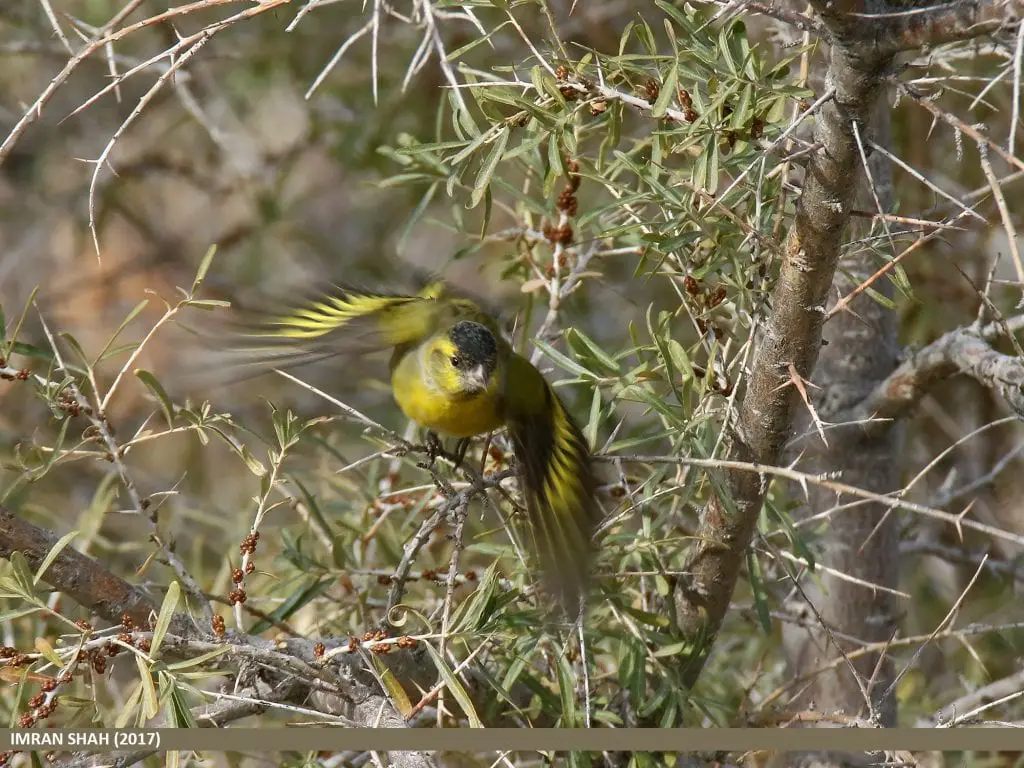
Eurasian siskins inhabit the north of Africa and most of Eurasia.
When it comes to these bird’s breeding areas, it is separated into two zones. Each of these two zones is located on each side of the Palearctic ecozone. The first breeding zone encompasses Asia’s east coast, while the second breeding zone encompasses the northern and central parts of Europe.
Spinus spinus can be found in Central Europe throughout the year, as well as in some mountain ranges located south of Europe. The siskins that are found in Russia and north Scandinavia are known to over-winter around the Black Sea area and in the Mediterranean basin.
The Eurasian siskins that breed in Jiangsu province and Inner Mongolia’s Khingan Mountains over-winter in Taiwan, Yangtse River’s lower valleys, and in Tibet.
Occasionally, siskins can be seen in North America, too, where their closely related counterpart, namely Spinus pinus (the pine siskin), thrives.
It is the anomalous migration pattern that determines the seasonal distribution of siskins. Every few years, large numbers of these birds are to migrate southwards. This leads to the populations overwintering in the Iberian Peninsula is significantly augmented.
The migration pattern of the Eurasian siskin is described as “anomalous,” as experts are still trying to figure out the cause for this bird species’ unusual migrations. According to one of the existing theories, such events occur in the years when the Norway spruce is to produce a rich crop of seeds in the north and central Europe, leading to the increase of siskin populations.
According to yet another theory, greater migration may be triggered in the case the preferred food sources, consisting of birch and alder seeds, are lacking.
Ultimately, the Eurasian siskin is not a bird that remains for too long in one single area. Instead, this is a bird that is to vary the areas used for over-wintering, feeding, and breeding, following a year to the next year pattern.
When it comes to the Eurasian siskins’ habitat, they are known to have a predilection for forested areas that are humid and located at a particular altitude. The preferred type of habitat consists of coniferous woodland. Forests, where spruce is dominant, are the favored choice for breeding, even though these birds will also breed in mixed woodland.
In the winter, siskins prefer stubble. They prefer areas and crops where seed-bearing trees are available.
Food & Diet
The main part of the Eurasian siskin’s diet consists of seeds; hence, this bird is mainly a granivore. However, depending on the season, the diet varies.
Siskins avoid eating on the ground, and instead, they feed in trees.
During the breeding season, which takes place in spring, siskins can be found in coniferous forests, as their feeding at that time depends on coniferous trees’ seeds. In particular, siskins share a preference for the seeds of the trees in the genera Picea, Larix, and Abies. Additionally, they also gladly feed on poplars and elms.
While feeding their young, siskins are known to take more insects in their diet, predominantly beetles. That’s because insects are high in protein, and protein helps the young to develop and grow properly.
During the autumn and winter season, the siskins’ diet is mainly based on alder seeds, as well as on the seeds of other deciduous trees, like birch. During this part of the year, the birds will also visit pasture and various cultivated areas, joining other finches on a collective feast on the seeds of dandelions, knapweeds, thistles, Artemisia, sorrel, meadowsweet, and St. John’s wort.
In the summer season, the siskins’ diet is very varied, as the birds are to add different herbaceous plants to their traditionally conifer seeds based feeding routine, such as goosefoots, among other plants in the family Compositae.
Behavior
One of the most hotly debated, curious behavioral traits of the Eurasian siskin is none other but this species’ unusual migration patterns. Every few years, a large number of siskins are to migrate southwards. While the reasons for this intriguing behavior remain mostly a mystery up-to-date, it is suggested that food availability and climate change may be the backbone of the peculiar migration pattern of Spinus spinus.
Feeding upside down just like a tit, the common siskin is an acrobatic feeder, further described as a restless, very active, and social bird species.
It is especially during the autumn and winter when Eurasian siskins are to form small, cohesive flocks.
Because of being unusually trusting of humans, unlike many other birds, Eurasian siskins may often allow being observed from a short distance. However, during the breeding season, these birds become much more difficult to observe. They become more solitary and timid, too.
Interestingly, there is a unique form of a hierarchical structure within the group, created by a strong cohesion as members of the same sex (aka subordinates) have been observed to regurgitate food for the dominant members. This is known as “allofeeding” behavior, and the Eurasian siskin is one of the very few animal species exhibiting this behavior.
Similar to other finches, siskins have abounding, rapid flight pattern. Outside the breeding season, Spinus spinus is to form large flocks, often getting mixed with redpolls.
Reproduction
It is most commonly in the winter period, just before migration, when Eurasian siskin pairs are formed.
Adult males are to compete for the females quite aggressively. The male is to plump up the feathers located on the rump and the pileus. This makes him appear bigger, while also extending his tail and repeatedly singing, all being a part of the courtship ritual.
Additionally, males will make mating flights, even though considered not as impressive and eye-grabbing as the mating flights of other finches, by flying from one tree to another.
The nest of the Eurasian siskin is to be typically located at the end of a comparatively high branch. It is usually a conifer tree that siskins select to build a nest in. In general, the nest is to be positioned in such a manner as to be reasonably well-hidden; thus, is as difficult to see as feasible.
The nest is small-sized and shaped like a bowl. It is constructed out of dried grasses, lichen, and small, fine twigs. Furthermore, it is lined with down.
Siskins are known to form small colonies consisting of up to six pairs. The pairs’ nests are to be located close by each other.
It is in the middle of April when the first brood is born after the female is to lay 2 and up to 6 eggs. The eggs are dotted with tiny brown spots, while the main color of the egg’s body varies from light blue to light grey. The eggs measure about 16.5mm by 12mm.
It is solely the female’s responsibility to incubate the eggs. Incubation lasts for 10 and up to 14 days. The chicks are helpless upon hatching, relying heavily on parental care in order to survive.
The young are to leave the nest after 15 days. When leaving the nest, they are semi-feathered. They will nearby the nest area for up to 30 days, as it takes about a month for their plumage to be completed. Once the plumage is complete, the young will disperse.
Apart from the first brood in mid-April, common siskins do typically also have a second brood. The second brood is born from mid-June to mid-July.
Survival Threats & Conservation
Currently, the global population of Eurasian siskin appears stable. The worldwide population is estimated at between 20-36 million, with the European population alone accounting for between 2.7 – 15 million pairs of sexually mature Spinus Spinus individuals.
As of now, the IUCN Red List of Threatened Species has listed the Eurasian siskin’s conservation status as Least Concern. That’s because there isn’t a major decline in these birds’ populations to have been observed up-to-date, possibly making up for threatening the future survival of this species.
Spinus spinus is a protected bird species, though, as it appears in Berne Convention’s Annex II.
Human Interaction & Domestication
Because of its unique appearance and song, the Eurasian siskin is highly valued by many aviculturists as a domestic bird.
Spinus spinus is known to adapt fairly well to captivity. Also, this bird species does not require any specific care, which further makes it a valuable and desirable addition to the collections of bird care and breeding enthusiasts.
However, Eurasian siskins tend to be difficult to breed in captivity, unless plenty of patience and deep understanding of these birds is applied by the experienced breeder.
In captivity, these birds prove to be hardy, as apart from possibly showing certain intestinal pathologies related to poor diet, they are rarely affected by any specific disease.
Eurasian siskins do also form hybrids with some other members of the finch family, such as canaries, in captive interbreeding practices. Even in the absence of human intervention, hybridization is known to occur in the wild, as well. As pets, Eurasian siskins are described as very active, curious, entertaining, sociable, and nonetheless, trusting birds, with a song that is a delightful mix of trills and twitters.
Furthermore, siskins are beloved and welcome visitors to bird feeding stations.
Availability – Where to Get a Eurasian Siskin
It is possible to get a Eurasian siskin from a limited number of reputable vendors, such as finch farms, where Spinus spinus and other finches are raised in captivity, being cage bred and ringed.
Depending on the potential caregiver’s area of residence, it may or may not be possible to get a Eurasian siskin imported, so it tends to be difficult to add this feathery fellow to one’s private collection. For instance, in Australia, the only birds that can be imported are fowl.
Additionally, some vendors will refuse to sell a Eurasian siskin to anyone else but to selected breeders, and will only do so at a very high price.
Interesting Facts
1. The archaic names for the Eurasian siskin include aberdevine, barley bird, and black-headed goldfinch.
2. It was back in 1758 in the 10th edition of Systema Naturae when the siskin was first described by Linnaeus, under the scientific name Fringilla spinus. Just two years later, in 1760, the genus Carduelis was described by Brisson, and so the Eurasian siskin was then placed in this genus. Based on recent taxonomic studies, the common siskin was suggested to be placed in its current genus, the genus Spinus.
3. The scientific name “spinus” is from a word with an ancient Greek origin – “spinos.” “Spinos” is the name for a “now-unidentifiable bird.” The English name – “siskin” – is derived from the German dialect word “sisschen.”
4. Eurasian siskins have two calls, with the one being ascending, while the other being is descending. Occasionally, they will also issue a rattling, harsh “chirrup.” Throughout the year, siskins will keep singing, and they will often do so in groups.
5. There are many cultural depictions of the Eurasian siskin. For instance, postage stamps bearing this bird’s image have been issued in Belgium, Benin, Poland, and Gibraltar.
A statue of a siskin can be seen in Saint Petersburg, with the students at an elite local school in the city wearing uniforms in the color of this bird species.
In one of Elif Shafak’s novels – “Three Daughters of Eve,” – the siskin is mentioned in a pivotal scene when the heroine gets to discover a siskin with feathers in yellow and green.
6. The amount of black on the adult male siskin’s chin patch, as well as the size of the chin patch itself, are related to dominance within the flock.
7. Due to the increase in commercial conifer plantations, the British range of the Eurasian siskin has significantly expanded.
8. According to an ancient German legend, the siskin guards a magic stone in its nest. Thanks to this magic stone, the siskin can become invisible. The legend was born in relation to these birds’ change in behavior during the breeding season when they become much more difficult to observe than usually, as well as much more timid and solitary.
How to Care for the Eurasian Siskin
To take proper care of the Eurasian siskin, the first rule of thumb is to supply the bird with high-quality seeds, regardless of whether it comes to attracting siskins to bird feeding stations or taking care of the feathery fellow as a pet cage bird.
Never leave a siskin run out of oilseeds, as these birds’ metabolism is very high. Because of this, they require fine-quality oil seeds to keep them in pristine condition, with their energy levels being successfully kept high.
Some seeds that a common siskin will gladly feed on include linseed, de-shelled sunflower seeds, poppy seeds, conola (rape) seeds, and Niger (thistle or nyjer) seeds, among others.
If possible, collecting fresh buds and flowers from elm trees, as well as pine cones to feed the siskins with, is highly recommended.
To properly breed Eurasian siskins in captivity, it is best to take the male out as soon as the female starts laying eggs. Next, the male should be placed in a separate cage right beside the female’s cage. Alternatively, the pair can be housed in a double breeder.
The goal is to keep the male away from eggs within the first 5 days since 60% of captive males will eat the eggs. However, the male must be in the female’s sight, or else, she may abandon the eggs.
FAQ Section
Where Do Eurasian Siskins Live?
Eurasian Siskinslive in most of Eurasia, as well as in the north of Africa.
Is the Eurasian Siskin Endangered?
No, the Eurasian Siskin is considered endangered as of now, neither by the IUCN Red List of Threatened Species nor by the RSPB. The IUCN listed the Eurasian siskin as Least Concern, while the RSPB classified it as Green Status, indicating that there are no current threats to these birds’ populations in the foreseeable future.
How to Attract Siskins?
To attract siskins to your garden, add sunflower hearts to any standard form seed feeder, keeping in mind that these birds are social diners, so the best type of feeders is those with several ports. Siskins are also highly attracted to nyjer seeds, and nyjer seeds should be added to a special niger seed feeder.
Are Eurasian Siskins Migratory?
Eurasian siskins can be both migratory, as well as residential. These birds follow unusual migratory patterns, becoming increasingly popular as garden birds in recent years.

